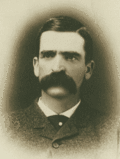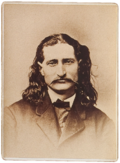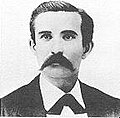This is a list of Old West lawmen: notable people who served in various law enforcement positions during the Old West period.
Contents
| Name | Portrait | Life | Years active | Comments | Ref. |
|---|---|---|---|---|---|
| John Hicks Adams | No image available | 1830–1878 | 1864–1878 | Sheriff, Santa Clara County, California, Deputy U.S. Marshal, Arizona Territory | |
| Alfred Shea Addis |  | 1832–1886 | 1883–1886 | Territorial Marshal, Tucson, Arizona 1883–1886; Deputy US Marshal, Grant County | [1] |
| Samuel B. Amidon |  | 1863-1925 | 1897-1901 | County Attorney, Sedgwick County, Kansas. Prosecuted Carrie Nation, once advised Bill Dalton, member of the Dalton Gang and leader of the Doolin-Dalton Gang | |
| William "Red" Angus | No image available | 1849–1922 | 1888–1893 | Sheriff, Johnson County, Wyoming | |
| Elfego Baca |  | 1865–1945 | 1884–1890 | New Mexico | |
| Phillip Cuney "P.C." Baird | No image available | 1862–1928 | 1882–1884 1888–1898 | Sheriff and Texas Ranger, Mason County, Texas | |
| Mariano Barela | No image available | 1837–1892 | Sheriff and U.S. Marshal, Mesilla, New Mexico | ||
| Joel Almon Bascom | No image available | 1832–1912 | Chief of Police, Provo, Utah and constable of Mona, Utah | ||
| John Watson Bell Bascom | No image available | 1869–1948 | Deputy Sheriff, Uintah County, Utah and constable of Naples, Utah | ||
| Charlie Bassett |  | 1847–1896 | 1873–1879 | Sheriff of Ford County, Kansas, Marshal of Dodge City [In Dodge Peace Commission Photograph Bassett is seated in the front row at far left] | |
| Johnny Behan |  | 1845–1912 | 1871–1882 | Sheriff, Cochise County, Arizona Territory | |
| Horace Bell |  | 1830–1918 | Los Angeles Ranger | ||
| James W. Bell | No image available | 1853–1881 | Deputy Sheriff, Lincoln County, New Mexico | ||
| Sam Bernard | No image available | 1880–1964 | Deputy Lincoln County, New Mexico, Hillsboro, New Mexico | ||
| Carl P.F. "Charles" Birkenfeld | No image available | 1852–1923 | 1904–1917 | Constable, Pima County, Arizona | |
| N. K. Boswell |  | 1841–1904 | Sheriff, Laramie, Wyoming | ||
| William J. Brady |  | 1829–1878 | 1869–1878 | Sheriff, Lincoln County, New Mexico | |
| Billy Breakenridge |  | 1846–1931 | Deputy Sheriff and U.S. Marshal, Cochise County, Arizona Territory | ||
| William L. Brooks |  | 1832–1874 | Marshal, Newton, Kansas and Dodge City, Kansas | ||
| Charles "Charley" J. Brown | No image available | 1845–1884 | 1875–1884 | Sheriff, Pembina County, Dakota Territory; Deputy U.S. Marshal, Dakota Territory | |
| Henry Newton Brown |  | 1857–1884 | Marshal, Tascosa, Texas (ghost town) and Caldwell, Kansas | ||
| Neal "Skinny" Brown | No image available | 1844–1926 | 1879–1895 | Assistant Marshal, Dodge City, Kansas; U.S. Marshal, Oklahoma Territory | |
| Seth Bullock |  | 1849–1919 | Sheriff, Lewis and Clark County, Montana; Sheriff, Lawrence County, South Dakota; U. S. Marshal Dakota Territorych | ||
| Mathew Caldwell | No image available | 1798–1842 | Gonzales Ranging Company of Mounted Volunteers 1836, Sheriff of Gonzales (Guadalupe, Dewitt, Caldwell, Lavaca) Counties 1837, Gonzales & Seguin Texas Rangers 1839 | ||
| Frank M. Canton |  | 1849–1927 | Sheriff, Johnson County, Wyoming; Deputy U.S. Marshal, Oklahoma Territory; Under Sheriff, Q County, Oklahoma | ||
| James W. Carr | No image available | 1845–1926 | Marshal Silverton, Colorado; Marshal Rico, Colorado; Deputy Sheriff Ouray County, Colorado; Deputy Sheriff Dolores County, Colorado | ||
| Charles Francis Colcord |  | 1859–1934 | Deputy U.S. Marshal, Oklahoma Territory; Chief of Police, Oklahoma, Oklahoma Territory | ||
| David J. Cook |  | 1842–1907 | Marshal, Denver, Colorado | ||
| "Longhair" Jim Courtright |  | 1848–1887 | Omaha, Nebraska Marshal, Marshal, Lake Valley, New Mexico; Sheriff, Fort Worth, Texas; Detective, Fort Worth, Texas | ||
| Frank Dalton |  | 1859–1887 | Deputy U.S. Marshal, Fort Smith, Arkansas, Oklahoma Territory | ||
| Ben Daniels |  | 1852–1923 | US Marshal, Pima County, Arizona sheriff, superintendent of Yuma Territorial Prison | ||
| James "Jim" M. Dodson | No image available | 1876–1890 | Prescott, Arizona City Marshal; Arizona State Penitentiary Wall Guard (post retirement) | ||
| Ed Drew |  | 1865–1911 | Pinal County, Arizona deputy sheriff | ||
| Morgan Earp |  | 1851–1882 | Deputy Sheriff, Ford County, Kansas; Marshal, Butte, Montana; U.S. Deputy Marshal, Arizona Territory; Deputy Policeman/Marshal, Arizona Territory | ||
| Virgil Earp |  | 1843–1906 | Deputy Policeman and Assistant Marshal, Dodge City, Kansas; Deputy U.S. Marshal, Prescott, Arizona; Deputy U.S. Marshal, Tombstone, Arizona; Marshal/Chief of Police, Tombstone, Arizona; Sheriff, Colton, California; Deputy Sheriff Esmeralda County, Nevada | ||
| Warren Earp |  | 1855–1900 | U.S. Deputy Marshal, Cochise County, Arizona Territory; Special Ranger (Arizona Cattleman's Association) | ||
| Wyatt Earp |  | 1848–1929 | Constable, Lamar, Missouri; Marshal (for 1 hour), Ellsworth, Kansas; Deputy Policeman, Wichita, Kansas; Assistant Marshal, Dodge City, Kansas; Deputy Sheriff, Pima County, Arizona, Arizona Territory); Deputy Policeman and Assistant Marshal, Tombstone, Arizona, Arizona Territory; Deputy U.S. Marshal, Arizona Territory | ||
| Stringer W. Fenton | No image available | 1865–1936 | Marshal, Indian Territory, Oklahoma, Osage County | ||
| John King Fisher |  | 1854–1884 | acting sheriff of Uvalde County, Texas | ||
| Camillus Sidney Fly | No image available | 1849–1901 | Sheriff, Cochise County, Arizona Territory | ||
| Pat Garrett |  | 1850–1908 | Sheriff, Lincoln County, New Mexico; Sheriff, Doña Ana County, New Mexico; Customs Collector, El Paso, Texas; Texas Ranger Captain, Texas | ||
| Lee Hall |  | 1849–1911 | Texas Ranger | ||
| Wiley G. Haines | No image available | 1860–1928 | Undersheriff, County P, Oklahoma Territory; Deputy U.S. Marshal, Oklahoma Territory; Chief, Osage Indian Police | ||
| John Coffee "Captain Jack" Hays |  | 1817–1883 | Captain in the Texas Rangers; first sheriff of San Francisco (1850) | ||
| Jack Helm | No image available | 1838–1873 | Sheriff, DeWitt County, Texas | ||
| James Butler "Wild Bill" Hickok |  | 1837–1876 | Marshal, Abilene, Kansas and Hays City, Kansas | ||
| John Henry "Doc" Holliday |  | 1851–1887 | Special Police Officer, Tombstone, Arizona Territory; Deputy U.S. Marshal Arizona Territory | ||
| John R. Hughes |  | 1855–1947 | Texas Ranger | ||
| James B. Hume |  | 1827–1904 | Marshal, Placerville, California; Undersheriff, El Dorado County, California; Sheriff, El Dorado County, California; Chief Detective, Wells, Fargo & Co. | ||
| Grant Johnson | No image available | 1858–1929 | Deputy U.S. Marshal, Indian Territory | ||
| John "Liver-Eating" Johnson | No image available | 1824–1900 | Deputy Sheriff/Town Marshal | ||
| John B. Jones |  | 1834–1891 | Texas Ranger | ||
| Jeff Kidder | No image available | 1875–1908 | Arizona Ranger | ||
| John M. Larn | No image available | 1849–1877 | outlaw and Sheriff, Shackelford County, Texas | ||
| James Franklin "Bud" Ledbetter | No image available | 1852–1937 | Deputy Sheriff, Johnson County, Arkansas; Deputy U.S. Marshal, Oklahoma Territory; Sheriff, Muskogee County, Oklahoma | ||
| Isaiah W. Lees | No image available | 1830–1902 | Detective, San Francisco, California | ||
| William Sidney "Cap" Light | No image available | 1864–1893 | Deputy Sheriff, Belton, Texas, Temple, Texas and Creede, Colorado | ||
| Steve "Big Steve" Long | No image available | d. 1868 | outlaw and Deputy Marshal, Laramie, Wyoming Territory | ||
| Harry Love |  | 1809–1868 | Captain, California State Rangers (1853–1855) | ||
| Chris Madsen | No image available | 1851–1944 | U.S. Marshal, Oklahoma Territory | ||
| Bat Masterson |  | 1853–1921 | Deputy Sheriff/Sheriff Ford County, Kansas; Marshal, Trinidad, Colorado; U. S. Deputy Marshal, Dodge City, Kansas; Peace Commissioner/Deputy U.S. Marshal, Southern District of New York | ||
| Ed Masterson |  | 1852–1878 | Marshal, Dodge City, Kansas | ||
| James Masterson |  | 1855–1895 | Dodge City, Kansas, Ford County, Kansas, Ingalls, Kansas, Deputy U.S. Marshal | ||
| Andrew "Andy" Mather | No image available | 1851–1929 | Texas Ranger, Williamson County, Texas, Co. E, Frontier Battalion, under Captain Maltby | ||
| Mysterious Dave Mather |  | 1851–? | 1880–1885 | Assistant Marshal Dodge City Kansas; Town Marshal New Kiowa Kansas | |
| Joseph McNulty |  | 1841–1909 | Sheriff, Rooks County, Kansas | ||
| Tolbert "Tol" Fannin McKinney | No image available | 1857–1938 | Lt. Texas Ranger, Co. D & E.; Frontier Battalion under Captains John R. Hughes & John H Rogers; Deputy Sheriff in Uvalde, Zavala, Bandera, Brewster, and El Paso Counties, Texas | ||
| Leander H. McNelly |  | 1844–1877 | Texas Ranger | ||
| William H. "High Water Bill" Moorhead | No image available | 1867–1870 | First sheriff of Pembina County, Dakota Territory which also made him the first sheriff in what is now the State of North Dakota; also served as Pembina town marshal, and Pembina County deputy sheriff. Nicknamed "High Water Bill" for his predictions on how high the flooding Red River of the North would get each spring, predictions that usually included the exchange of money and property. | ||
| David Neagle | No image available | 1847–1926 | Deputy Sheriff, Cochise County, Arizona Territory; Marshal, Tombstone, Arizona Territory; Detective, US Marshal, San Francisco, California | ||
| Evett Dumas Nix |  | 1861–1946 | US Marshal, Fort Smith, Arkansas, Nasty Nate, Kansas | ||
| Robert Bob Olinger |  | 1841–1881 | 1878–1881 | Deputy Sheriff, Lincoln County, New Mexico | |
| William Owen "Buckey" O'Neill |  | 1860–1898 | Sheriff, Yavapai County, Arizona | ||
| Commodore Perry Owens |  | 1852–1919 | Sheriff, Apache County, Arizona | ||
| Allan Pinkerton |  | 1819–1884 | Pinkerton Detective Agency Founder | ||
| Robert Pinkerton | No image available | 1848–1907 | Pinkerton Detective | ||
| William A. Pinkerton | No image available | 1846–1923 | Pinkerton Detective | ||
| Henry Plummer |  | 1837–1864 | Marshal, Nevada City, California; Sheriff Bannack, Montana | ||
| Robert Jack Price | No image available | 1848–1930 | Constable | ||
| Alexander Ramsey | No image available | 1847–1875 | Marshall, Hays City, Kansas, later, sheriff, Ellis County, Kansas, shot and captured Henry Born "Dutch Henry", shot and killed nine other outlaws in discharge of his duties | ||
| Bass Reeves |  | 1832–1910 | Deputy U.S. Marshal, Indian Territory | ||
| Porter Rockwell |  | 1813–1878 | Utah Territory | ||
| George Scarborough | No image available | 1859–1903 | El Paso, Texas Sheriff, killed John Selman | ||
| John Selman |  | 1839–1896 | El Paso, Texas Constable, killed John Wesley Hardin | ||
| Charles A. Shibell |  | 1841–1908 | 1875–1880; 1888 | Sheriff Pima County Arizona | |
| Charles Sims | No image available | 1879–1945 | Town Marshal Rosedale, Oklahoma | ||
| Charlie Siringo |  | 1855–1928 | Pinkerton detective | ||
| Sam Sixkiller | No image available | 1842–1886 | Captain, U.S. Indian Police, Indian Territory; Deputy U.S. Marshal, Indian Territory | ||
| John Slaughter |  | 1841–1922 | Sheriff and Texas Ranger, Cochise County, Arizona, Arizona Territory | ||
| Lot Smith |  | 1830–1892 | Sheriff Davis County, Utah; in March 1853, Farmington, then known as Little Cottonwood, was approved by Utah Territorial Legislature as the County seat of Davis County; a year later, Lot Smith, who also served in Mormon Battalion at age 16, was appointed county's first sheriff | ||
| Thomas Smith |  | 1830–1870 | Marshal and Deputy U.S. Marshal, Kit Carson, Colorado and Abilene, Kansas | ||
| Con Stapleton | No image available | 1848–1879 | Marshal, Deadwood, South Dakota | ||
| Dallas Stoudenmire |  | 1845–1882 | El Paso, Texas Marshal and Texas Ranger; Deputy U.S. Marshal | ||
| Michael Sughrue | No image available | 1844–1901 | Sheriff, Clark County, Kansas; Marshal Ashland, Kansas; Deputy Sheriff, Ford County, Kansas; Deputy Marshal, Dodge City, Kansas | ||
| Henry Andrew "Heck" Thomas |  | 1850–1912 | Deputy U.S. Marshal, Oklahoma Territory | ||
| Ben Thompson |  | 1842–1884 | Marshal, Austin, Texas | ||
| Bill Tilghman |  | 1854–1924 | Deputy Marshal, Dodge City, Kansas; Deputy U.S. Marshal, Oklahoma Territory; Sheriff, Lincoln County, Oklahoma; Chief of Police, Oklahoma City, Oklahoma | ||
| James Timberlake |  | 1846–1891 | Deputy Marshal, Liberty, Missouri; County Sheriff, Clay County, Missouri; Constable, Liberty, Missouri | ||
| Paden Tolbert |  | 1863–1904 | Deputy U.S. Marshal, Indian Territory | ||
| Max Ventura | No image available | 1866– | U.S. Marshal, Indian Affairs Delegate, North Dakota Territory | ||
| John Joshua Webb | No image available | 1847–1882 | Deputy Marshal, Dodge City, Kansas; Marshal, Las Vegas, New Mexico | ||
| Franklin Pierce West | No image available | 1852–1886 | Indian Territory Deputy Marshal | ||
| William Fletcher Wheeler | No image available | 1824–1894 | Montana Territory U.S. Marshal 1869–1878, Lt Col, 1st MN Vol Inf, 1858–61, Capt, Co F, 4th MN Inf, 1861–64 (WIA at Vicksburg, Mississippi), 3rd U.S. Marshal in the Montana Territory, 1869–78; founder of Montana Historical Society | ||
| Fred White |  | 1849–1880 | Marshal Tombstone, Arizona Territory; died in the line of duty | ||
| Robert Widdowfield |  | 1846–1878 | Wyoming Deputy sheriff, first Wyoming officer to be killed in the line of duty | ||
| Robert Widenmann | No image available | 1852–1930 | Deputy U.S. Marshal New Mexico Territory | ||
| Charlie Wilson | No image available | 1860–1889 | City Marshal, Oceanside, California 1888–1889 | ||
| Jefferson "Keno" Wilson | No image available | 1862–1934 |